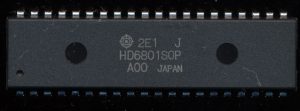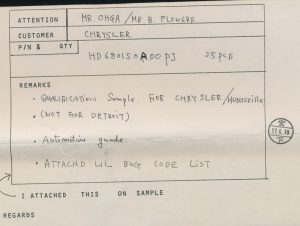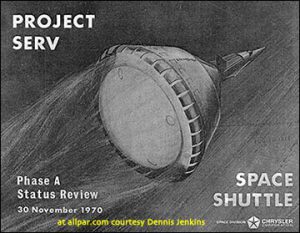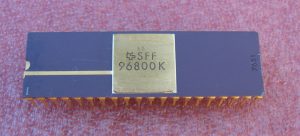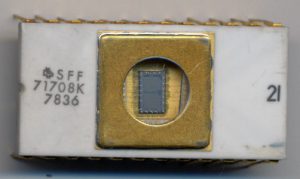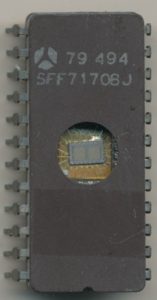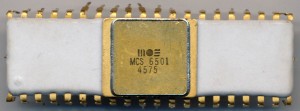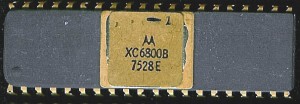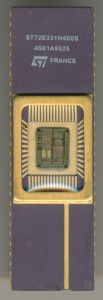CPU of the Day: Hitachi HD6801S0PJ – Automotive 6801
The original Motorola MC6801 was released in 1977, built on a 5.1u NMOS process with 35,000 transistors (some sources say 25,000, which may be the ‘active’ transistor sites). One of the very first customers was General Motors, you can read more about that in last years article on the 6801. Hitachi was the primary second source for Motorola, primarily to supply the Japanese market, but they also competed with Motorola in the US market as well. Hitachi released their version of the 6801 in 1980, with full production commencing in 1981. It was made on a 3-micron NMOS process and was available in both a 1MHz speed (HD6801S0) and 1.25MHz (HD6801S5). Around this time (1982) Hitachi was also transitioning their part numbering system. Originally these parts were HD468xx… which was a bit confusing so they dropped the ‘4’. For several years in the early 1980’s it is not uncommon to find parts with either, or both part numbers on them.
The pictured Hitachi HD6801S0P in interesting for a couple reasons. The A00 denoted the ROM code for the 2K of onboard ROM. A00 means that it is unprogrammed. This would be useful for testing the 6801 with an external EPROM etc. The ‘J’ on the package denotes that this device is a industrial/automotive spec part with an increased temperature range, in this case -40-85C. Hitachi date codes are different from other manufacturers but are relatively simple. The code 2E1 denotes the first week (1) of May (E) in 1982 (2).
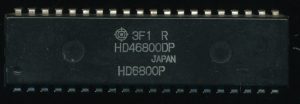
Hitachi marked with both old and new part numbers
HD46800DP and HD6800P – dated 3F1 – First week of June 1983
| Year* | Month** | Week |
| 8 – 1978 | A – January | 1 – Week 1 |
| 9 – 1979 | B – February | 2 – Week 2 |
| 0 – 1980 | C – March | 3 – Week 3 |
| 1 – 1981 | D – April | 4 – Week 4 |
| 2 -1982 | E – May | 5 – Week 5 |
| 3 – 1983 | F – June | |
| 4 – 1984 | G – July | |
| 5 – 1985 | H – August | |
| 6 – 1986 | J – September | |
| 7 – 1987 | K – October | |
| 8 – 1988 | L – November | |
| 9 – 1989 | M – December |
*Years repeat, so 0 is used from 1980 and 1990
** ‘I’ is skipped to avoid confusion with the number ‘1’
What is perhaps more interesting is what came with this CPU when the museum got it. Its often hard to figure out what a CPU/MCU was used in, or what it was for, its provenance. This 6801 offers some help. It came in an original Hitachi box, with a copy of a fax from Hitachi in Japan to the Hitachi sales office in the USA. The fax denotes that these are qualification samples, automotive spec, and for a particular customer. That customer is Chrysler (the automotive company now owned by Fiat).
Also included on the fax is an original Japanese date stamp (June 1982 (Showa year 57)) . These 6801s were fresh off the production line, having been made only a few weeks earlier. The fax states these are for Chrysler in Huntsville, AL. with a reminder that they are “Not for Detroit” (where most of Chrysler production was. That is an interesting addition, and important, as Chrysler did (it closed in 2011) have a very large presence in Huntsville, AL. Huntsville is known as Rocket City, home of the Redstone Arsenal, where a large amount of US rocket, missile, and space engineering have taken place. It was also the home of Chrysler Electronics (as well as most all of Chrysler’s military and space programs. It was Chrysler who built the Saturn 1 and Saturn 1B upper stages for the NASA Apollo program. Chrysler Electronics also built much of the Grown system electronics for the Apollo program as well as vehicle testing equipment for the M1 tank, the M2/3 Bradley and a host of other military programs.
Chrysler also proposed the Single-stage Earth-orbital Reusable Vehicle (SERV) during the design phase of what became the Shuttle program.
In the early 1970’s electronic use in cars was growing rapidly, leading Chrysler to greatly expand their presence in Huntsville. These 6801s were likely for testing for cars, though it is unclear if Chrysler actually used the 6801 in their vehicles as ECUs from the mid-80’s all seem to be running the 6803 and 6805 MCUs. Maybe if I find an early 80’s Chrysler I’ll tear out the ECU and find out.


